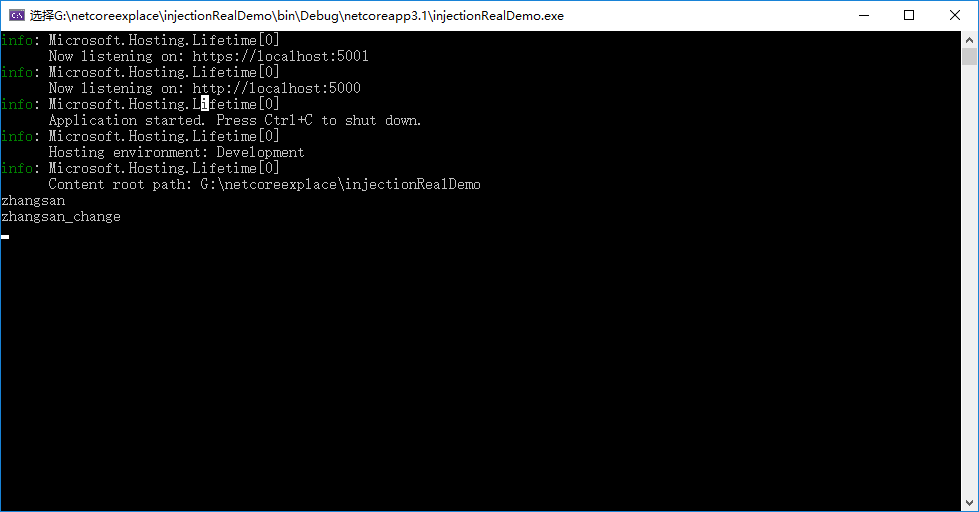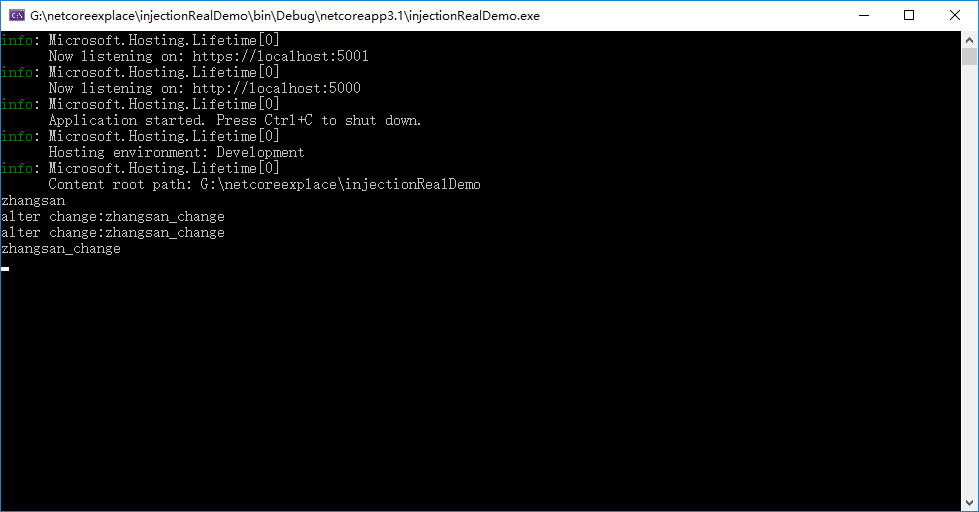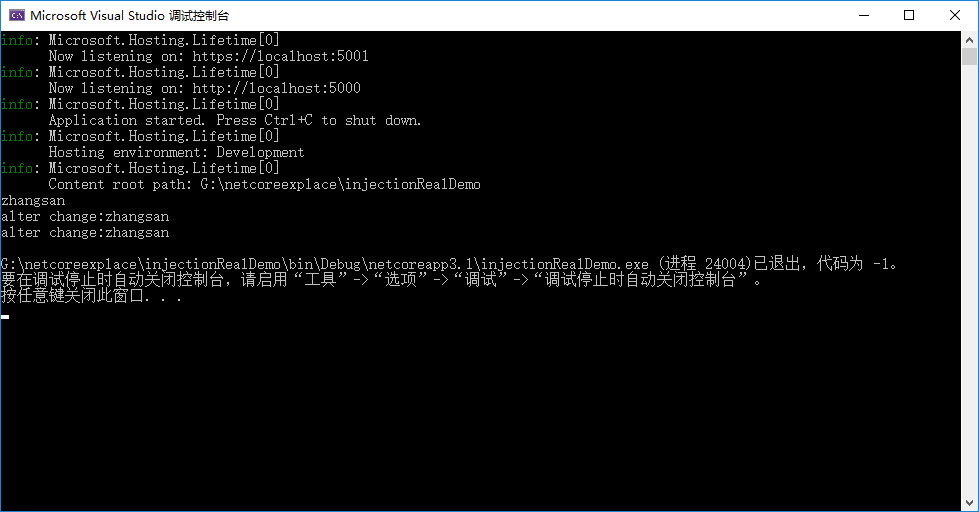前言
前文講述了,服務和配置直接的配合,這一節寫一下,當配置檔案修改了,每個服務如何感知自己的配置。
正文
服務感知到自己的配置發生變化,這就牽扯出兩個東西:
IoptionsMonitor<out TOptions>
IoptionSnapshot<out TOptions>
在作用域範圍使用IoptionSnapshot,在單例中使用IoptionsMonitor 。
IoptionsMonitor
先來演示作用域範圍的使用。
配置:
{
"SelfService": {
"name" : "zhangsan"
}
}
SelfServiceOption:
public class SelfServiceOption
{
public string Name { get; set; }
}
服務:
public class SelfService : ISelfService
{
IOptionsSnapshot<SelfServiceOption> _options;
public SelfService(IOptionsSnapshot<SelfServiceOption> options)
{
this._options = options;
}
public string ShowOptionName()
{
return _options.Value.Name;
}
}
註冊:
services.Configure<SelfServiceOption>(Configuration.GetSection("SelfService"), BinderOptions =>
{
BinderOptions.BindNonPublicProperties = true;
});
services.AddScoped<ISelfService, SelfService>();
測試:
[HttpGet]
public int GetService([FromServices]ISelfService selfService)
{
Console.WriteLine(selfService.ShowOptionName());
return 1;
}
結果:

第一次訪問後修改為zhangsan_change,再次訪問介面,會呈現上述效果。
那麼為什麼使用IoptionsMonitor,而為什麼Ioptions 沒有用呢。
前一篇寫過Ioptions 的實現類OptionsManager,這個是有快取的_cache,如下:
public class OptionsManager<TOptions> : IOptions<TOptions>, IOptionsSnapshot<TOptions> where TOptions : class, new()
{
private readonly IOptionsFactory<TOptions> _factory;
private readonly OptionsCache<TOptions> _cache = new OptionsCache<TOptions>(); // Note: this is a private cache
/// <summary>
/// Initializes a new instance with the specified options configurations.
/// </summary>
/// <param name="factory">The factory to use to create options.</param>
public OptionsManager(IOptionsFactory<TOptions> factory)
{
_factory = factory;
}
/// <summary>
/// The default configured <typeparamref name="TOptions"/> instance, equivalent to Get(Options.DefaultName).
/// </summary>
public TOptions Value
{
get
{
return Get(Options.DefaultName);
}
}
/// <summary>
/// Returns a configured <typeparamref name="TOptions"/> instance with the given <paramref name="name"/>.
/// </summary>
public virtual TOptions Get(string name)
{
name = name ?? Options.DefaultName;
// Store the options in our instance cache
return _cache.GetOrAdd(name, () => _factory.Create(name));
}
}
IoptionsMonitor的實現類也是OptionsManager,但是人家是作用域模式。
在Addoptions中:
services.TryAdd(ServiceDescriptor.Singleton(typeof(IOptions<>), typeof(OptionsManager<>)));
services.TryAdd(ServiceDescriptor.Scoped(typeof(IOptionsSnapshot<>), typeof(OptionsManager<>)));
也就是說每建立一個SelfService,就會建立一個OptionsManager。快取自然只在作用域內有效。
好的,那麼來看下單例。
IoptionsMonitor
服務:
public class SelfService : ISelfService
{
IOptionsMonitor<SelfServiceOption> _options;
public SelfService(IOptionsMonitor<SelfServiceOption> options)
{
this._options = options;
_options.OnChange((selftServiceOptions) =>
{
Console.WriteLine("alter change:"+selftServiceOptions.Name);
});
}
public string ShowOptionName()
{
return _options.CurrentValue.Name;
}
}
註冊:
services.Configure<SelfServiceOption>(Configuration.GetSection("SelfService"), BinderOptions =>
{
BinderOptions.BindNonPublicProperties = true;
});
services.AddSingleton<ISelfService, SelfService>();
測試介面:
[HttpGet]
public int GetService([FromServices]ISelfService selfService)
{
Console.WriteLine(selfService.ShowOptionName());
return 1;
}
同意是修改錢訪問一次,修改後訪問一次。
結果如下:

那麼看下IOptionMonitor的實現類OptionsMonitor:
public class OptionsMonitor<TOptions> : IOptionsMonitor<TOptions>, IDisposable where TOptions : class, new()
{
private readonly IOptionsMonitorCache<TOptions> _cache;
private readonly IOptionsFactory<TOptions> _factory;
private readonly IEnumerable<IOptionsChangeTokenSource<TOptions>> _sources;
private readonly List<IDisposable> _registrations = new List<IDisposable>();
internal event Action<TOptions, string> _onChange;
/// <summary>
/// Constructor.
/// </summary>
/// <param name="factory">The factory to use to create options.</param>
/// <param name="sources">The sources used to listen for changes to the options instance.</param>
/// <param name="cache">The cache used to store options.</param>
public OptionsMonitor(IOptionsFactory<TOptions> factory, IEnumerable<IOptionsChangeTokenSource<TOptions>> sources, IOptionsMonitorCache<TOptions> cache)
{
_factory = factory;
_sources = sources;
_cache = cache;
foreach (var source in _sources)
{
var registration = ChangeToken.OnChange(
() => source.GetChangeToken(),
(name) => InvokeChanged(name),
source.Name);
_registrations.Add(registration);
}
}
private void InvokeChanged(string name)
{
name = name ?? Options.DefaultName;
_cache.TryRemove(name);
var options = Get(name);
if (_onChange != null)
{
_onChange.Invoke(options, name);
}
}
/// <summary>
/// The present value of the options.
/// </summary>
public TOptions CurrentValue
{
get => Get(Options.DefaultName);
}
/// <summary>
/// Returns a configured <typeparamref name="TOptions"/> instance with the given <paramref name="name"/>.
/// </summary>
public virtual TOptions Get(string name)
{
name = name ?? Options.DefaultName;
return _cache.GetOrAdd(name, () => _factory.Create(name));
}
/// <summary>
/// Registers a listener to be called whenever <typeparamref name="TOptions"/> changes.
/// </summary>
/// <param name="listener">The action to be invoked when <typeparamref name="TOptions"/> has changed.</param>
/// <returns>An <see cref="IDisposable"/> which should be disposed to stop listening for changes.</returns>
public IDisposable OnChange(Action<TOptions, string> listener)
{
var disposable = new ChangeTrackerDisposable(this, listener);
_onChange += disposable.OnChange;
return disposable;
}
/// <summary>
/// Removes all change registration subscriptions.
/// </summary>
public void Dispose()
{
// Remove all subscriptions to the change tokens
foreach (var registration in _registrations)
{
registration.Dispose();
}
_registrations.Clear();
}
internal class ChangeTrackerDisposable : IDisposable
{
private readonly Action<TOptions, string> _listener;
private readonly OptionsMonitor<TOptions> _monitor;
public ChangeTrackerDisposable(OptionsMonitor<TOptions> monitor, Action<TOptions, string> listener)
{
_listener = listener;
_monitor = monitor;
}
public void OnChange(TOptions options, string name) => _listener.Invoke(options, name);
public void Dispose() => _monitor._onChange -= OnChange;
}
}
給每個給做了監聽哈:
foreach (var source in _sources)
{
var registration = ChangeToken.OnChange(
() => source.GetChangeToken(),
(name) => InvokeChanged(name),
source.Name);
_registrations.Add(registration);
}
這個IOptionsChangeTokenSource怎麼來的呢?是在我們的configure配置方法中:
public static IServiceCollection Configure<TOptions>(this IServiceCollection services, string name, IConfiguration config, Action<BinderOptions> configureBinder)
where TOptions : class
{
if (services == null)
{
throw new ArgumentNullException(nameof(services));
}
if (config == null)
{
throw new ArgumentNullException(nameof(config));
}
services.AddOptions();
services.AddSingleton<IOptionsChangeTokenSource<TOptions>>(new ConfigurationChangeTokenSource<TOptions>(name, config));
return services.AddSingleton<IConfigureOptions<TOptions>>(new NamedConfigureFromConfigurationOptions<TOptions>(name, config, configureBinder));
}
看到這一段:services.AddSingleton<IOptionsChangeTokenSource>(new ConfigurationChangeTokenSource(name, config));。
當有修改後,那麼會呼叫:
private void InvokeChanged(string name)
{
name = name ?? Options.DefaultName;
_cache.TryRemove(name);
var options = Get(name);
if (_onChange != null)
{
_onChange.Invoke(options, name);
}
}
這裡面會移除快取_cache.TryRemove(name);,然後重新新呼叫: Get(name);也就會再繫結一次。
這裡面有一個值得注意的是,如果有回撥,不一定是本身這個服務的配置修改,可能是其他服務的配置修改了,也會被通知,因為這個是檔案發生變化就會被通知。
原理如下:
GetSession會返回一個 ConfigurationSection。那麼它裡面的GetReloadToken是這樣的:
public IChangeToken GetReloadToken() => _root.GetReloadToken();
這返回了ConfigurationRoot的GetReloadToken。
實驗一下:
{
"SelfService": {
"name": "zhangsan"
},
"SelfService2": {
"name" : "good one"
}
}
改成:
{
"SelfService": {
"name": "zhangsan"
},
"SelfService2": {
"name" : "good one1"
}
}
結果:

索引我們可以在服務裡面配置增加一個version版本號,如果版本修改了,然後才做相應的操作。
結
以上只是個人整理,如有錯誤,望請指點。
下一節:配置驗證。